At Dental Marketing Guy (DMG), we’ve provided SEO for orthodontists for more than a decade. Our experience gives your practice a clear advantage in competitive local search.
Our work helps you reach the right patients through orthodontist SEO services that improve visibility and support stronger conversions.
The expert online marketing team at DMG optimizes your website so it feels trustworthy and easy to navigate. We use results-driven digital marketing for orthodontists to strengthen credibility and reduce friction before a patient chooses a provider.
This support also helps you generate consistent leads through your website instead of relying solely on ads.
Our approach stays centered on real patient behavior. We help you connect with people who are actively comparing treatment options.
That alignment gives your practice a stronger advantage in the moments that shape their decisions.
Many orthodontists want an SEO partner who explains things clearly and delivers real results.
The review below by Peter Kim below shows how DMG supports new practice owners by simplifying SEO and helping them grow with a clearer understanding of what drives their success.
Over the past few months, I’ve had the pleasure of working with Justin, who I found on Dentaltown. As a new practice owner, I was unsure about how to approach marketing and really felt overwhelmed with SEO. Justin has been incredibly helpful in guiding me through it all. Thanks to his advice, I've seen a real boost in new patient numbers. What I really value about Justin is that he makes things easy to understand. He doesn’t just throw a bunch of marketing jargon at me—he breaks it down so I know what’s happening and why. He also takes the time to tailor his recommendations to my practice’s specific needs, which makes all the difference. I’m really grateful to have found someone like Justin to help me navigate this part of owning a practice. He’s been a great partner in helping me grow, and I’m excited to see what we can achieve together moving forward.

Prospective orthodontic patients search differently than general dental patients. They also take longer to make a decision.
Orthodontic treatment requires a higher financial commitment. Because of that cost, parents and adults compare several providers before contacting a practice.
For this reason, early visibility is non-negotiable. Strong orthodontic SEO methods performed by a specialist create that visibility at the right moment. Local SEO for orthodontists plays a key role at this stage by helping your practice appear during early, location-based research.
As a result, your practice shows up near the top of search results when families begin exploring options. Visibility continues to build as interest grows.An orthodontic SEO specialist supports that momentum over time. Your practice stays ahead of local competitors when families move from research to comparison.

Patients mostly want clear information about orthodontic services during their initial search. Many begin by checking braces options. Others compare aligner choices.
In fact, they look for the services you want so badly to provide. Cost research often shapes their subsequent steps. Treatment results usually influence final decisions.
It stands to reason that a website that answers these questions early on with a good user experience is going to earn more trust.
That trust keeps your practice on the patient’s shortlist as they move from research to commitment.
This level of commitment usually becomes a scheduled appointment for your orthodontic services, and you want to keep those appointments coming with effective SEO.At this stage, strategic online marketing for orthodontists helps present services, costs, and treatment options clearly to parents and adult patients during their research phase.
You will find your orthodontist practice:
With a strong orthodontic SEO system, your practice becomes the clear choice in your local market. It happens because your website answers patient questions better than competitors, not because of guesswork.
Looking for a real search engine optimization service tailored for orthodontists?
You are here because I rank across the major search engines for the same types of keywords your orthodontic practice needs. I achieved that by using the exact SEO strategies I now use for my clients.
My business appears for terms like ‘dental SEO expert,’ ‘dental SEO specialist,’ and ‘dental SEO company,’ and these same methods strengthen visibility for orthodontic searches such as ‘affordable braces,’ ‘Invisalign for adults,’ and ‘overbite correction.’
If you want a full breakdown of the techniques I use to help orthodontists attract new patients, schedule a 15 minute Marketing Discovery call with me.
When orthodontists search on Google, Bing, and other major platforms for SEO services for orthodontists, they are trying to find someone who truly understands how orthodontic patients search online. You have already taken the first smart step by finding a specialist who focuses exclusively on this work.
This experience matters because SEO marketing for orthodontists works best when it is guided by proven rankings, real patient search behavior, and strategies that convert visibility into consultations.
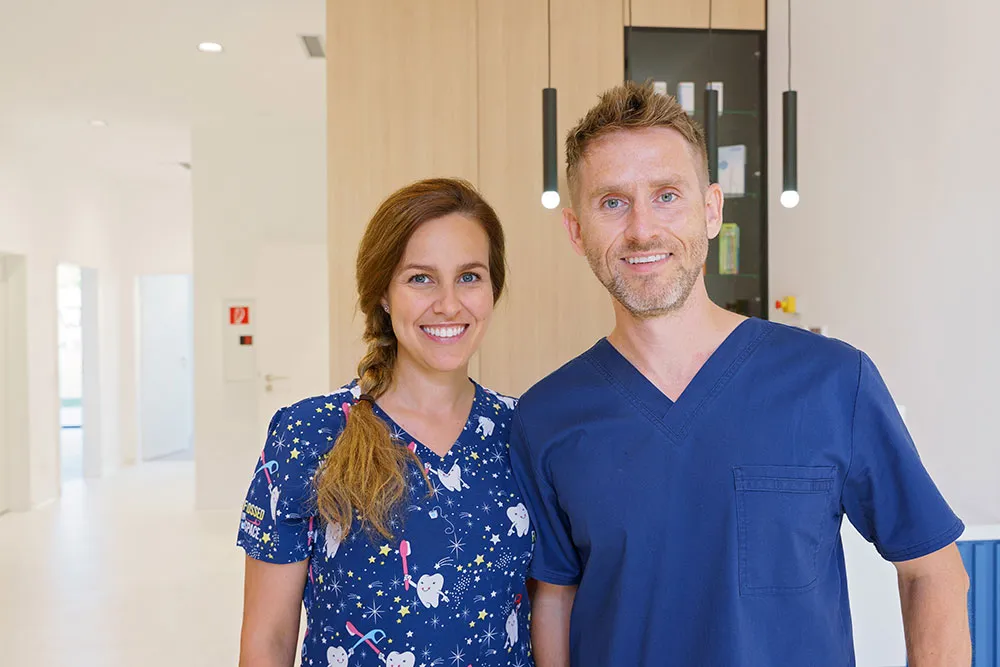
Your orthodontic practice needs a steady flow of new, qualified patients. Strong online visibility in search results helps the right people find you at the right time.
Your orthodontic practice needs a steady flow of new, qualified patients. Strong online visibility in search results helps the right people find you at the right time.
When the orthodontist marketing team at DMG performs keyword research, that research focuses on how real patients search for orthodontic care. Their insight reveals where comparison, hesitation, and evaluation happen during the decision process.
DMG also provides the following effective SEO services for orthodontists:
Combined, these efforts create clarity throughout the research process.
Clear messaging supports high-intent searches and reduces confusion during the research phase. That clarity builds trust and makes it easier for patients to schedule a consultation.
As a result, your practice appears for searches like “orthodontist near me,” “orthodontist reviews,” and “metal braces cost,” connecting visibility directly to real consultation opportunities.
Orthodontic practices face a very different search landscape than general dentists. The right orthodontic SEO team can use that to your advantage by applying targeted techniques that match how people evaluate treatment options.
DMG supports this process through orthodontic seo strategies that reflect how patients evaluate care at each stage of the decision process. Content and site structure work together to support comparison, guide research, and reduce uncertainty before contact.
The orthodontic SEO marketing experts at DMG understand that patients compare costs, case results, timelines, and financing options with great care. They need clear information before they reach out, and they want to feel confident before taking the next step.Every effective orthodontic SEO technique DMG uses answers deeper questions and demonstrates real expertise. These techniques also reduce digital hurdles that can prevent a parent or adult patient from scheduling.
The orthodontic SEO system DMG uses focuses on the specific needs of orthodontic practices. Our approach blends local visibility with conversion-driven content. The system gives your practice a clearer path to attracting more new patients.
In short, you get a strategy built to help you rank higher and build trust with people already searching for orthodontic care in your area.
You can also explore the Ultimate Guide to Orthodontic SEO Strategy at the end of this page for a deeper understanding of how orthodontic SEO works and how it supports long-term growth.
It outlines the methods we use for orthodontists across the country, gives you helpful FAQs we get asked by orthodontists a lot, and much, much more.
Not every SEO company is equipped to help an orthodontic practice grow. In fact, search engine optimization for orthodontist practices requires a strategy that differs from general dental SEO because the competition and patient behavior are very different.
General dentists now target orthodontic keywords, which increases competition in search results.
Patients also spend more time researching before committing because treatment plans last longer and the financial investment is higher.
Search engine optimization for orthodontists must address these factors and support the specific way orthodontic patients make decisions.

Prospective patients researching orthodontist practices want clarity about comfort and results. They also want to be informed about timelines and cost. And they want those reassurances before they schedule a consultation, not after.
Effective orthodontic SEO focuses on high-intent searches and provides helpful information early in the process. It's a hard truth, but many general dental SEO plans do not support this deeper level of decision-making.
Another major difference between the two is how orthodontists compete in online search. Orthodontists rely heavily on patients easily finding their websites through search engine results pages (SERPs).
Strong placement in search results makes it much easier for motivated patients to notice your practice before they look at competitors.
Also importantly, strong visibility in these results depends on an SEO strategy built around real patient search patterns. When we make your website content align with those searches, it becomes easier for motivated potential patients to discover your practice in the SERPs.
Orthodontists face digital challenges that can slow growth when left unaddressed. These challenges shape how your practice appears in search and how patients decide where to schedule a consultation.
General dentists now compete for orthodontic search terms. Many promote Invisalign and other clear aligners or basic orthodontic care. This tendency affects your rankings and reduces your share of high-intent traffic. A specialized orthodontic SEO plan helps you stay visible when dentists appear for orthodontic keywords.
Paid ads are costing more each year. Orthodontic search terms remain among the most expensive in dentistry. Many practices see rising cost per click and cost per consultation. Strong organic visibility helps balance these costs and reduce long-term marketing spend.
Also, when DMG uses effective SEO for orthodontists methods, your practice appears prominently in search. It will drive traffic to your site for less cost than traditional advertising methods.
Orthodontic patients compare several providers before they contact a practice. They browse online and look for photos and reviews. They also carefully consider treatment options and proof of expertise.
Websites without clear messaging or helpful content tend to lose visitors quickly. Good SEO supports this decision cycle by offering helpful, reassuring information.
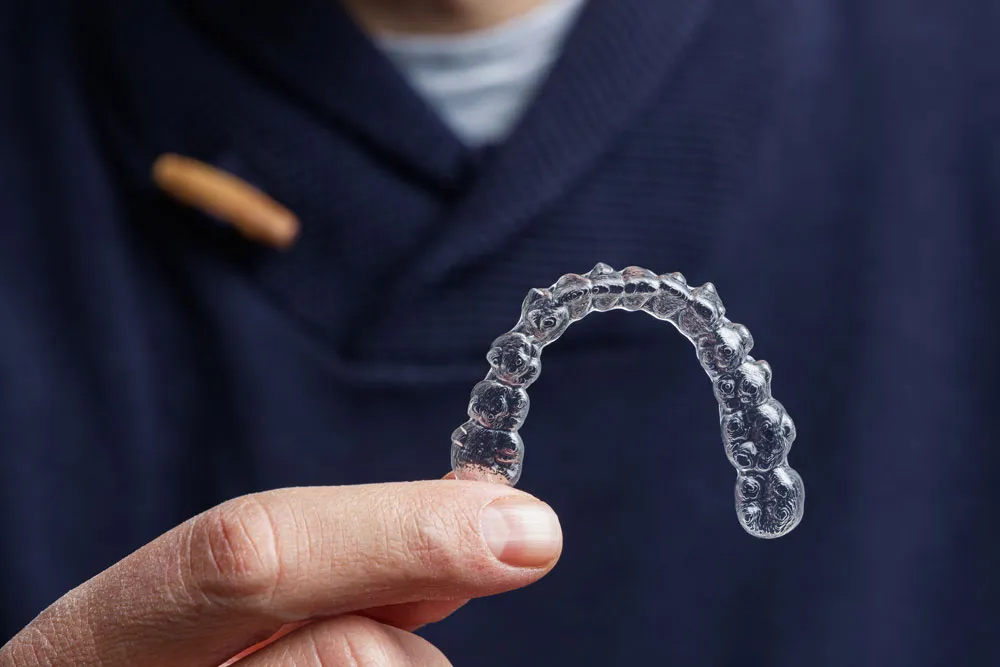
National aligner companies fill major orthodontic search results. Their presence reduces impressions for local orthodontists. A focused orthodontic SEO plan helps your practice reclaim visibility in your local area.
Many agencies use the same SEO plan for general dentists and orthodontists. These plans often focus on low-value keywords and generic content. They do not support treatment-specific questions or patient concerns.
Orthodontic practices need a more detailed, patient-focused approach through strategic SEO for orthodontists.
Accurate tracking is essential for orthodontic SEO. Many practices do not have call tracking, form tracking, or reporting tied to measurable outcomes. Clear data helps your practice understand what works and guides smart improvements.
Practices that rely on outdated digital strategies lose ground. Competitors gain visibility. Advertising costs rise. Consultations slow down. Schedules become less predictable.
That all adds up, and visibility declines even when clinical outcomes are excellent. That is not a reflection of your skill. It is a sign that your SEO has fallen behind what patients expect online.
If you want to ensure potential customers can find your orthodontic practice online, a modern orthodontic SEO strategy is needed. It will help avoid these challenges and support long-term growth.
DMG provides a complete orthodontic SEO system that supports your visibility and lead flow. We also boost and support your local reputation. The service includes the core components needed to rank well and attract more qualified patients.
Each part works together to build trust and improve performance. Ultimately, our orthodontic SEO services guide visitors toward that ever-important consultation.
Your orthodontic marketing plan works best when you know what is being done each month. DMG provides a clear structure that supports visibility, trust, and steady patient growth.
This framework removes guesswork and shows exactly how your investment moves the practice forward.
Here are some of the orthodontic SEO services and digital marketing techniques that you get with DMG:
DMG offers three levels of orthodontic SEO service. Each tier below increases the amount of content, authority work, and strategic involvement you'll receive.
You can choose the level that fits your goals, as each is structured to match your practice’s growth stage and needs.
DMG begins with SEO consulting for orthodontists to evaluate your market, competition, and current online performance. This consultation helps identify gaps, opportunities, and the right level of support for your practice.
We also provide SEO for dental practices. Our experience across dental search environments helps ensure your strategy reflects how patients research providers and make treatment decisions.
Whether you want SEO for dentists or SEO for ortho, the team at DMG helps you choose the right service tier and builds a plan around your specific goals.
This service supports orthodontists who want stronger visibility and better-qualified leads. It also helps practices that need more predictable consultation volume. Many of these practices compete with general dentists or national aligner brands. Some want clearer reporting and tighter control over their marketing performance.
Our approach to SEO for orthodontic practices helps create more predictable consultation volume and clearer growth patterns.
Many of these practices compete with general dentists or national aligner brands. Others want clearer reporting and tighter control over marketing performance.

Orthodontists in competitive metro areas see strong results from this approach. Multi-location practices with expanding service zones also benefit. Solo practices that want to increase aligner cases or boost overall patient flow use this strategy as well.
Finally, teams that want a transparent plan with reliable reporting find it helpful.
Orthodontic patients take more time to decide. They compare costs and case results with care. They also look for information that helps them feel confident before they reach out.
A focused orthodontic SEO program must support that behavior. It must build trust and reduce friction that slows down the decision to schedule.
As your plan gains traction, your practice earns more authority in local search. Your content becomes a helpful resource for families researching treatment options.
Additionally, your reviews improve as more patients engage with your practice. These outcomes support stable scheduling and steady growth.
DMG specializes in dental and orthodontic SEO. Our experience helps us understand how orthodontic patients search and what they want to know first. We use that insight to support visibility and conversions in competitive markets.
Many practices evaluating providers and looking for the best SEO for orthodontist growth need a partner who understands competitive markets and patient-driven search behavior.
Our work highlights clarity and trust signals. We target high-intent orthodontic keywords and build content that answers patient questions. We support local visibility with accurate information and consistent updates that help your practice stay ahead of nearby competitors.

Our signature orthodontic search engine optimization system addresses the challenges orthodontists face online. It improves your visibility, strengthens your messaging, and supports your online reputation. Each part works together to support steady patient growth.
Search engine "crawlers" have to understand your pages clearly before they can rank them. That process depends on several core elements working together, including:
When these pieces work in sync, your practice benefits across visibility, traffic, and conversions. The graphic below breaks down the results you can expect.
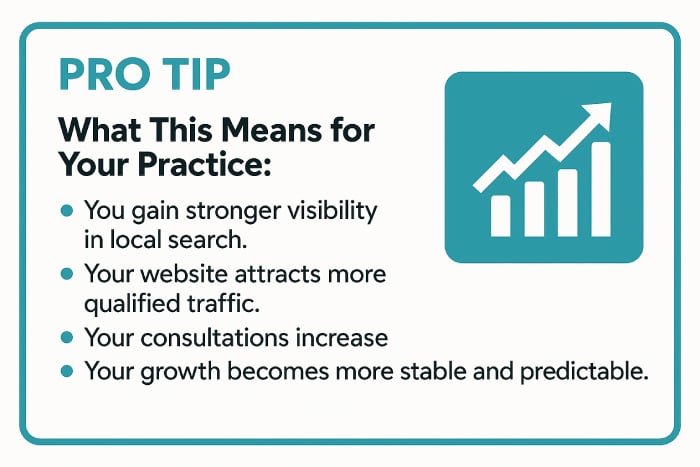
Here’s what orthodontic and dental clients have shared about their experience working with DMG.

We have been working with Justin, the DentalMarketingGuy. They have a good grasp on various dental office marketing strategies such as SEO and Google Ads. They have helped us refine our keyword targeting, optimize our ad spend, and improve our website ranking across key search terms. This has resulted in increased organic traffic, higher conversion rates, and a stronger online presence overall and consistent quality leads. They are quick to respond and their communication is excellent. We highly recommend them as partner if you are looking to grow your dental practice.
Justin has been great in walking me through the process of online marketing. I look forward to working with him more. He is accessible, friendly and wanting to help. Thanks Justin!

Staying ahead of SEO trends matters for orthodontic practices. Digital marketing changes quickly, and your SEO strategy needs to adapt so competitors do not pass you in local search.
Voice search, mobile experience, and richer search results already shape how patients find orthodontic care.
Schema markup, reviews, and local signals will continue to influence which practices appear first when someone searches for braces or aligners in their area.
Strong orthodontic SEO means watching these changes, testing new approaches, and updating your site regularly. The practices that stay current will hold more visibility and stronger reputations. The result? A steadier pipeline of consultations.
Most people search for orthodontists on mobile devices and ask specific treatment questions. Their behavior sends signals to Google about which practices deserve visibility.
Clear, trustworthy content helps answer those questions. Accurate schema markup tells search engines what your pages mean. Reviews and local activity show your practice is relevant and well-regarded.
Together, these factors influence where you rank and how often new patients discover your practice. Staying proactive with orthodontic SEO ensures your visibility continues to grow over time.
Topic clusters organize related orthodontic content around a central theme and helps search engines understand your expertise and improves search ranking. This structure also makes it easier for patients to move through your site as they research treatment options.
AI tools can support this work by suggesting cluster topics, identifying gaps, and helping you build strong internal links between a pillar page and its supporting pages. This type of organization builds topical authority and improves how both search engines and users understand your practice.
Practices that stay current will find they gain more visibility, stronger reputations, and a steadier flow of consultations.

This guide walks you through the main elements of DMG’s orthodontic SEO approach. It also explains how we support your practice each month and where your team can participate when helpful.
Backlinks help Google determine which parts of your website deserve authority.
Here is the simple idea behind them:
Orthodontists gain strong backlink opportunities through local engagement, smart content creation, and accurate directory listings. Each category supports authority in a different way.
Local involvement creates reliable backlink opportunities. Directory listings from chambers, event sponsors, and professional associations strengthen visibility. Partnerships with nearby providers and participation in community programs also lead to natural mentions on trusted sites.
Effective content marketing for orthodontists focuses on creating useful, relevant information that answers patient questions and builds trust over time.
Instead of promoting services directly, content such as blog posts, treatment guides, FAQs, videos, and educational visuals helps prospective patients understand orthodontic care and feel confident choosing a provider.
High-quality content also earns backlinks naturally. Guest articles on reputable dental or healthcare websites provide safe, authoritative links.
Shareable resources like infographics, treatment explainers, or before-and-after education pieces attract links when other sites reference them as helpful sources. Practice updates, educational announcements, or community-focused content can also generate mentions from local media and industry blogs.
Content marketing is a really effective strategy since it:
Accurate listings on respected directories support local search authority. Profiles on platforms like Healthgrades, Yelp, and Google reinforce trust and include a link to your website. These listings strengthen your backlink foundation and improve visibility.
Most orthodontic research now happens on mobile devices. If your site loads slowly or has layout problems on phones, potential patients will bail quickly. Strong mobile SEO fixes that issue by improving traffic and strengthening scheduling behavior.
The Pro Tip below highlights what every orthodontic mobile site needs to perform well.
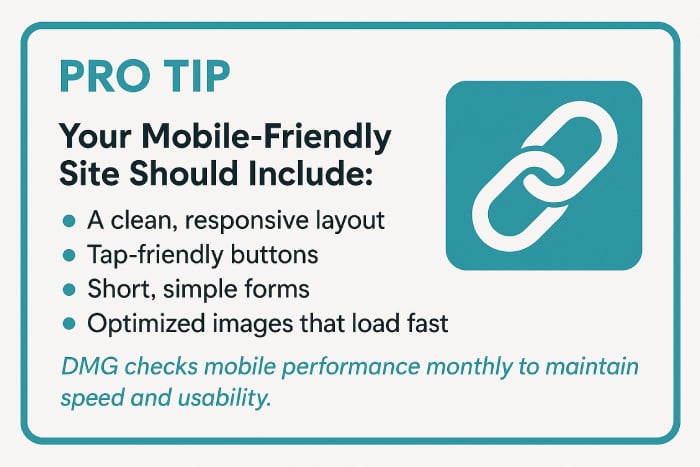
Technical SEO helps Google crawl and index your orthodontic website without hitting roadblocks. DMG fixes internal structure issues that confuse search engines, resolves indexing problems that keep pages out of results, and improves load speed so pages open faster on all devices.
Some orthodontic sites also struggle with broken links, template problems, or outdated code. To fix these issues, the technical specialists at DMG review how your site is built and cleans up these issues so search engines and patients both move through your content more easily.
Reviews influence how parents and adult patients judge your practice, and they carry significant weight in local search. DMG shows your team how to request feedback consistently and position your strongest ones where new visitors naturally look first.
DMG improves your review process by helping you:
DMG reporting stays focused on metrics that matter to orthodontists. Instead of clutter or vanity numbers, you see data tied directly to real activity from potential patients.
Your reporting highlights:

Schema markup provides structured information that helps search engines understand your orthodontic content. When done correctly, it improves rich-result eligibility and click-through rates.
DMG validates all schema using Google’s testing tools.
Orthodontic practices in competitive markets need more than standard optimization. Advanced SEO helps your practice reach patients who compare several providers, search in different formats, and expect clearer information before they schedule.
DMG applies these methods when traditional SEO is not strong enough to keep your practice visible.
Advanced tactics cover a wide range of strategies, but video and voice search stand out for orthodontists. These formats match how many patients now research treatment and they influence several ranking signals at once.
They also give independent practices a way to compete with national aligner brands that rely on media rich content to attract attention.
DMG prioritizes video and voice search because both formats fill major content gaps found on most orthodontic websites. Patients want quick explanations, simple visuals, and answers phrased the way they naturally speak, and these formats deliver that experience more effectively than text alone.
Short treatment videos build trust and increase time on page. They also help visitors compare braces and aligner options with greater confidence. Voice-search-friendly FAQs capture conversational questions people ask through phones and home assistants, which supports visibility in spoken queries.
Together, these audio and visual formats expand your presence across typed searches, video results, and voice-activated tools. They provide clarity for patients and stronger signals for search engines and make your content more competitive in every format.
Local SEO for orthodontists determines whether your practice appears in map results and local Google panels. DMG maintains your location signals so your practice stays visible.
Your team can support this by gathering new photos and collecting more reviews.
SEO-friendly design helps visitors move through your site with less effort. Clear structures help users find what they need and feel confident enough to schedule.
These elements help orthodontists attract and convert more qualified traffic.
Email brings patients back to optimized pages. More branded searches and repeat visits strengthen signals that support better SEO performance.
DMG aligns email topics with your SEO strategy to reinforce your visibility.
Orthodontists benefit when their website makes information easy to scan. Readability supports both SEO and conversions.
DMG structures content based on what patients search for and how they navigate.
DMG manages the complex, technical, and strategic parts of your SEO plan. Orthodontic teams support the strategy by providing practice-specific insights that only you can supply.
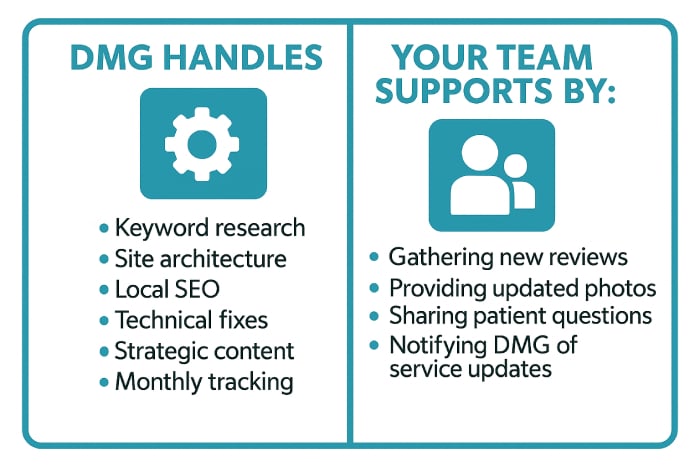
This collaboration produces a stronger, higher-performing SEO system.
DMG focuses on transparent, meaningful reporting so you always know what your investment delivers. Here's what you receive as part of that tracking and how your strategy adjusts.
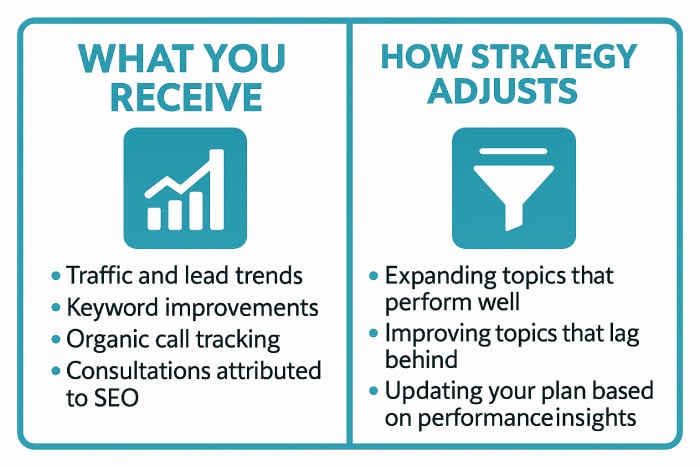
Keyword research should guide which pages you build and how you phrase your content.
Tools like Ahrefs help you perform keyword research. Through them, you discover what people actually type when they look for your products and services.
That valuable data gives you a roadmap instead of making you guess which orthodontic topics deserve their own pages.
Most orthodontic patients search close to home, so local visibility is often more important than national reach.
When your Google Business Profile, NAP data, and location pages are handled properly, you show up more often in maps and local packs.
That is where high-intent “orthodontist near me” searches usually go first.
Content works best when it supports a clear strategy rather than a pile of unrelated topics.
This structure helps both search engines and patients understand your expertise.
You get more value from strong basics than from scattered advanced tricks.
Unique content, clean title tags, accurate meta descriptions, and solid internal linking often move the needle faster than complex experiments.
Once that foundation is stable, advanced tactics become much more effective.
Key technical areas worth regular attention:
Orthodontic SEO campaigns struggle when the underlying site is slow or unstable, even if the content is strong.
Google needs confidence that your orthodontic practice is real, active, and located where you say it is.
Consistent listings in dental directories, local listings, and healthcare sites support that trust.
Any time your address, phone number, or branding changes, your citations should be reviewed and corrected.
SEO does not live in isolation. Email campaigns, social media posts, and short videos can all send people back to optimized pages. These touches increase branded searches and repeat visits, both of which help your organic performance.
Marketing channels DMG might use to to support the SEO efforts for your orthodontic practice include:

Review requests are crucial, as they influence both rankings and human decisions.
An orthodontic practice with a steady stream of recent, positive reviews will usually convert better than a quiet profile, even when rankings are similar.
To grow your reviews, you can:
Those steps build trust that your SEO efforts then amplify.
In crowded markets, orthodontists often need more precise tactics to stand out. Topic clusters around aligners, early treatment, or complex cases can establish authority in narrow areas.
Voice-search-friendly FAQs and long-tail keyword targets help you capture detailed searches that generic dental SEO plans overlook.
Orthodontic SEO needs ongoing adjustment, not a one-time setup. Tracking organic calls, form fills, consultations, and keyword movement shows which pages pull their weight.
Meanwhile, regular reviews let you expand winning topics, repair weak pages, and keep your strategy aligned with actual patient behavior and search trends.
Interested? Learn how Dental Marketing Guy's Digital Marketing Strategy is superior to anything else you'll find in orthodontics.
Read on to see how you can support your SEO between professional campaigns.
You do not need to be an SEO expert to support your practice online. The ideas below give you simple ways to improve your content, strengthen your local presence, and support your visibility in organic search results.
Behind the scenes, DMG will manage the technical aspects and strategic work that requires deeper expertise.
Email marketing keeps relationships warm and reminds patients that your practice is active and helpful.
You can send a simple monthly newsletter that links to your latest blog posts or FAQs. Every click back to your site increases traffic and engagement signals in Google, which supports your overall search engine optimization efforts.
A platform like Mailchimp or a similar email tool makes it easier to manage lists, send campaigns, and track opens and clicks.
Your Google Business Profile is one of the strongest signals for local SEO. Accurate details help nearby patients find you when they search for care.
Make sure these items stay updated:
Additional steps include:
Listing your practice in local directories such as Google Maps, Yelp, and healthcare platforms reinforces these signals and supports better visibility in local search results.
Keyword research helps you see the phrases potential patients actually type into Google and other search engines. Start by typing in terms such as:
Google Keyword Planner allows you to:
Likewise, adding selected keywords to your headings, meta descriptions, and on-page content helps search engines understand your page topics more clearly.
Search engines reward content that provides genuine value. Start by answering the questions patients bring up during consultations.
Short blog posts, quick FAQs, comparison charts, and treatment explainers all help. You can also share anonymized patient success stories, timeline expectations, or before-and-after cases (with permission).
Mixing formats makes your content easier to read:
This type of content builds trust with potential patients and strengthens your overall SEO performance.
Reviews drive both trust and local visibility. A steady flow of new reviews shows Google that your practice is active and reliable.
You can:
Platforms such as Google, Healthgrades, and Yelp all support local signals. Regular review activity helps your practice appear higher when families compare options.
We can’t emphasize this one enough. Orthodontic searches happen mostly on mobile devices. A slow or unresponsive site creates frustration and increases bounce rates.
A few simple checks help:
A clean, fast mobile experience supports better ranking and increases conversions.
Local citations help confirm your practice information across the web. Backlinks from reputable sources strengthen your authority. Google views backlinks as a vote of confidence, especially when they come from authoritative and local websites.
To support this, you can build relevant links by focusing on credible, location-based sources such as dental associations, local news organizations, and health-related platforms. These placements increase trust and reinforce your local SEO signals.
Easy starting points include:
Each mention or link reinforces your practice’s credibility in search engines and strengthens your overall visibility.
Finally, use tools like Google Analytics and Google Search Console to understand how your website performs. These tools show how your content affects your Google ranking, giving you clearer insight into what’s helping you appear in search.
You can monitor:
These insights help you spot which topics interest patients most, which pages need improvement, and how your SEO is progressing over time.
In simple terms, SEO, or search engine optimization, is the process of improving a site’s visibility in organic search results. People can find your practice more easily when your website appears for the searches they type into search engines like Google, Bing, and DuckDuckGo.
SEO for orthodontics applies this same methodology but focuses on the specific factors that help an orthodontic practice grow. It introduces the nuances of ranking for braces, aligners, treatment questions, and local searches so more nearby patients discover your practice and choose you with confidence.
Unlike general SEO specialists, orthodontist SEO experts understand the unique challenges and needs of orthodontic practices. These experts focus on targeting patients seeking orthodontic services, making their strategies more tailored to your field.
Certainly! An SEO for orthodontist strategy helps your practice appear when people search for aligners, braces, and second opinions in your area. You highlight expertise, case results, family-friendly, and in-person care that large brands cannot match.
This approach lets SEO for orthodontist campaigns reclaim traffic that would otherwise go to general dentists or national aligner companies.
Strong SEO for orthodontists’ methodology and marketing campaigns should lead to more organic calls, more form fills, and a higher share of local search visibility.
DMG tracks keyword movement, booked consultations, and patient behavior so you see the connection between SEO work and real outcomes. Over time, our SEO for orthodontists system helps reduce reliance on expensive ads and supports steadier growth.
No. SEO for orthodontics also targets questions about cost, comfort, timelines, and treatment options. Pages that answer “braces vs aligners,” “Invisalign for adults,” and “early treatment” support a healthier funnel. When your SEO for orthodontics strategy covers these topics, you stay visible from the first search to the final decision.
You know SEO for orthodontists is working when organic consultations rise and key terms move up in search results. Tracking tools show which pages bring in calls and forms, not just clicks.
In simple terms, SEO, or search engine optimization, is the process of improving a site’s visibility in organic search results. People can find your services and your practice information on search engines when your site appears for the terms they use.
SEO for orthodontics applies this same methodology but focuses on the specific factors that help an orthodontic practice grow. It introduces the nuances of ranking for braces, aligners, treatment questions, and local searches so more nearby patients discover your practice.
The best results come from consistent effort and ongoing optimization. DMG offers three tiers of orthodontic SEO service, and depending on which one you choose, we can review these numbers with you. With a steady plan in place, you’ll be able to see how SEO for orthodontists supports growth month after month.
Orthodontist SEO focuses on searches for braces, aligners, overbite correction, and teen treatment. These searches involve longer decision cycles and higher price sensitivity. A general dental SEO plan often fails to support these deeper questions.
Furthermore, orthodontic SEO prioritizes orthodontic treatment-specific content and stronger trust signals. It also involves keyword targeting that maps to actual patient behavior.
• Orthodontic treatment takes longer
• Costs are higher
• Results matter more visually
• Parents compare multiple providers
DMG designs SEO around those decision factors.
Orthodontist SEO focuses on optimizing websites for orthodontic practices. It uses local keywords like "orthodontist in [city]" to attract patients in your area. This helps improve your website's visibility and organic traffic compared to regular SEO.
A website can have great content yet still struggle if it loads slowly, breaks structure, or has crawl issues. Technical SEO ensures search engines can read, index, and trust every page of your orthodontic website.
Common technical issues orthodontists face:
• Duplicate content from Invisalign or vendor-provided pages
• Outdated code that slows down mobile devices
• Missing meta data
• Broken links on treatment pages
How DMG helps:
We fix these issues monthly so your site stays clean, fast, and compliant with search engine standards.
Duplicate content can hurt your website's ranking on Google. Search engines prefer unique, high-quality content. Make sure each page has original content to build authority and trust with both search engines and patients.
User experience (UX) makes a significant impact to your orthodontic practice's SEO. User experience (UX) is key for keeping visitors on your site and reducing bounce rates. A well-designed website with easy navigation, fast loading speeds, and mobile-friendly layouts keeps users engaged. Good UX signals to search engines that your site is valuable, which can improve your rankings.
DMG improves user experience by creating a clear site structure that makes navigation simple for patients and easy for search engines to crawl. We organize your pages into a logical hierarchy, strengthen internal linking, and ensure your main navigation is easy to follow. These updates help visitors find important information faster and help search engines index your content more effectively.
DMG also supports performance by optimizing meta tags, improving URLs, and ensuring your website is fast and mobile-friendly. These improvements make your site easier to use and help strengthen your overall SEO visibility.
A strong orthodontist SEO campaign helps improve your website’s visibility and increase organic traffic from nearby patients. As this visibility grows, your practice becomes easier to find in local searches, which supports steady consultation volume.
Local SEO ensures your orthodontic practice appears in the map pack and local results when someone searches “braces near me” or “orthodontist in [city].”
• Google Business Profile accuracy
• NAP consistency across directories
• Location-specific keywords
• Photos, Q&As, reviews
Parents often choose the practice that appears first in local search. Visibility drives consultation volume.
Local citations and ensuring NAP (Name, Address, Phone number) consistency across all online platforms help boost local SEO. Accurate and consistent information makes it easier for search engines to verify your practice, improving your chances of showing up in local search results and Google Maps.
To further strengthen this visibility, make sure your Google Business Profile is fully claimed and verified. Verified profiles have a better chance of appearing in the Google Map results, especially when patients in your area search for orthodontic services.
Your practice becomes more visible in local searches when your local SEO strategy focuses on geographic relevance. You can add your town and nearby towns to your copy, meta descriptions, and page titles. These placements help search engines understand the areas you serve.
Claiming and optimizing your Google Business Profile also supports visibility in local searches. In fact, keeping accurate, up-to-date information on your Google Business Profile is the number one factor in local search rankings. Beyond that, adding your practice to local directories strengthens these signals even further.
These steps help your orthodontic practice appear higher when nearby patients look for treatment options.
Hiring an orthodontic SEO expert leads to SEO success through Google Business Profile optimization, building local citations, and incorporating geographically relevant keywords. This helps your orthodontic practice appear in local search results when potential patients search for services near them.
How can you check your local SEO ranking using relevant keywords?
You can check your local SEO ranking by searching for relevant keywords directly in Google. Type phrases like “orthodontics Chicago” or “orthodontic dentist Dallas” and look at where your practice appears in the results. The position you see in Google reflects how patients in your area experience your visibility for those searches.
Reviews strengthen both ranking signals and conversion rates. Google uses review quality, volume, and recency as trust indicators.
DMG supports you by:
• Helping your team collect reviews consistently
• Adding reviews to key pages
• Implementing review schema that enhances search appearance
Strong reviews reduce friction for new patients.
Social proof, like patient testimonials and reviews, can enhance your dental SEO marketing. Positive reviews build trust and credibility, encouraging more patients to choose your services.
Adding these elements on your website and Google Business Profile listing can improve visibility and conversion rates.
You need to use relevant keywords for your website to rank higher in online search results. Keyword research identifies terms real patients use. This includes searches for braces, aligners, costs, timelines, and treatment options.
Effective orthodontic keywords include:
• Aligners questions
• Braces cost comparisons
• Teen treatment concerns
• Adult orthodontics searches
Patients scan your website for quick, clear answers before they schedule a consultation. Strong, well-organized content builds trust and keeps visitors engaged longer, which supports positive SEO signals.
Content creation includes blog posts, FAQs, and patient success stories. It also involves developing detailed, helpful service pages that give patients the information they need about your treatments and expertise.
Long-tail keywords, like "best orthodontist for Invisalign in [city]," target specific searches and are less competitive. Using these in your SEO strategy can attract targeted traffic, leading to better engagement and higher conversion rates.
An SEO orthodontist specialist is a digital marketing professional who improves an orthodontic practice’s online visibility.
They conduct online marketing for orthodontists by using targeted keyword research, strategic content development, and optimized local search efforts.
Their goal is to help orthodontists rank for terms like “braces near me,” “Invisalign,” "crooked teeth treatment" and other treatment-focused searches.
This role is a core part of digital marketing for orthodontists and supports broader digital marketing for orthodontist practices focused on patient acquisition.
A specialist understands patient intent and competitive orthodontic keywords. Their work helps you appear in the right search results at the right moment, which drives qualified traffic and more consultation requests.
A specialist understands patient intent and competitive orthodontic keywords.
Their work helps you appear in the right search results at the right moment through orthodontic practices SEO strategies, driving qualified traffic and more consultation requests.
Content supports both effective SEO strategies and broader digital marketing efforts. High-quality content answers patient questions, builds trust, and improves rankings for competitive orthodontic search terms.
An SEO orthodontist specialist also performs content gap analysis to uncover topics competitors cover that your site lacks. When DMG creates content, it is more thorough and more informative so your practice gains an edge.
How long does it take an SEO orthodontist specialist to achieve results?
Timelines depend on your current website condition and local competition. Many orthodontic practices begin seeing improvements within a few months. Sustained work delivers the strongest, most stable growth.
Schema markup highlights your practice details, services, FAQs, and reviews. This improves rich-result eligibility and helps Google understand your content.
Examples of schema DMG implements:
• LocalBusiness
• Service
• FAQ
• Review
Why long-tail keywords matter:
Searches like “Invisalign for adults in [city]” bring more qualified traffic and lower competition than broad terms.
Structured data and schema markup help search engines understand your website content better. This can increase your chances of appearing in rich results, making your practice stand out in Google Search and attract more leads.
Yes, indirectly. Social content increases brand searches, drives traffic, and improves awareness. These signals support stronger rankings over time.
Other channels that reinforce SEO:
• Email newsletters
• Video content
• Community posts
• Local partnerships
Cross-channel activity strengthens overall visibility.
Email marketing and newsletters keep patients informed and engaged. By sharing valuable content, you boost your website's traffic and SEO by driving more interactions and brand mentions. Regular updates also help maintain top-of-mind awareness.
Google and Bing are the biggest. Yes, SEO works on Bing and other search engines, but with different ranking factors than Google. While many core SEO principles, like quality content and user experience, apply across platforms, Bing and other search engines like Yahoo, YouTube, and Amazon have unique algorithms that emphasize different signals. Optimizing for other search engines can diversify traffic, reduce competition, and reach different demographics.
Backlinks: Bing may place more emphasis on the quantity of backlinks, while Google prioritizes their quality and authority. Some search engines also consider domain age and extension when evaluating links.
What makes an orthodontic SEO specialist different from a general SEO provider?
General SEO agencies usually miss orthodontic search behavior, patient concerns, and treatment terminology. Orthodontic SEO specialists understand high-intent searches, decision drivers, and competitive aligner markets.
How DMG stands out:
• Dental-only focus
• Treatment-specific keyword research
• Knowledge of aligner competition
• A month-to-month system built around measurable outcomes
An orthodontic SEO expert is a professional who specializes in optimizing websites for orthodontic practices to improve their search engine rankings. By hiring an expert, orthodontists can attract more patients and grow their online visibility.
Hiring an orthodontic SEO expert ensures that your practice is optimized for rankings, making it easier for potential patients to find you online. An orthodontic SEO knows the latest SEO strategies and can tailor them specifically to the orthodontic field.
An orthodontic SEO expert provides a range of services, including keyword research, on-page SEO, link building, content optimization, and local SEO strategies. These services are designed to help orthodontists rank higher on search engines.
Orthodontist SEO experts specialize in optimizing orthodontic websites to achieve higher search engine rankings. Orthodontist SEO experts focus specifically on the needs of orthodontists to help them attract more patients online.
Orthodontist SEO experts use proven SEO strategies like keyword research, local SEO, content optimization, and backlinking to increase the visibility of your orthodontic practice. By partnering with orthodontist SEO experts, you can expect better rankings and more traffic to your website.
Unlike general SEO specialists, orthodontist SEO experts understand the unique challenges and needs of orthodontic practices. Orthodontist SEO experts focus on targeting patients seeking orthodontic services, making their strategies more tailored to your field.
Yes, orthodontist SEO experts are skilled in helping orthodontists acquire more patients by making their websites more discoverable. Orthodontist SEO experts use techniques that drive traffic from potential patients searching for orthodontic services.
Orthodontist SEO experts analyze the competition in your area and implement strategies to help you stand out. Orthodontist SEO experts may focus on building authoritative backlinks and creating localized content to outperform competitors in search engine visibility.
Most practices see meaningful improvements within 3–6 months, depending on competition and starting point.
DMG’s reporting keeps you informed with:
• Keyword trends
• Organic call logs
• Form submissions
• Consultation tracking (where supported)
We refine your strategy using data, not guesswork.
The timeline for results depends on various factors, including your current website status and competition. Typically, an orthodontic SEO expert can start showing improvements within 3-6 months of optimizing your site.
SEO efforts for orthodontists can fail when the strategy does not match how orthodontic patients search or when the website lacks the technical foundation needed for strong visibility. Problems also occur when agencies do not specialize in orthodontics or when local optimization is incomplete.
Other common issues that can hurt SEO efforts for orthodontists include:
DMG handles strategy, optimization, and technical components. Practices can accelerate progress by contributing assets only they can provide.
Helpful contributions you do to update your orthodontic website include the following:
If you want your bounce rate to skyrocket, use generic stock images that look nothing like your practice. A much better approach is to share high-quality photos that show your real space, team, and patient experience. Authentic images keep visitors engaged longer and support stronger on-site performance.
You have a couple of reliable options for capturing the updated photos your website needs. Both approaches work well, and DMG supports you through whichever path fits your practice.
We can connect you with a company that focuses on orthodontic and dental imagery so your photos accurately represent your team, your office, and the level of care you provide.
This option works well if you need flexibility with scheduling or patient consent. We help you plan the shots so your images still meet the standards required for strong website performance.
No matter which option you choose, DMG guides you on what to capture and how to use those photos to strengthen engagement and support your overall SEO strategy.
Before-and-after photos play a major role in how patients evaluate orthodontic treatment. These images help people understand realistic outcomes and give them the reassurance they need when comparing providers.
A strong collection of case images also supports SEO because it improves engagement, builds trust, and signals expertise.
You can gather case photos as part of your normal workflow by capturing images at key milestones. DMG can guide you on which angles, lighting, and formats work best for your website.
If you need help organizing or labeling your photos, we can assist with that as well. High-quality case images make a powerful impression and help your treatment pages perform better in search.
The power of FAQs, which stands for frequently asked questions, can’t be underestimated. Websites that offer services or in-depth information often rely on FAQs because they give visitors quick, direct answers without extra searching.
Therefore, you should jot down the questions your patients ask most often, because they are a big part of what people look for online.
When you share those questions with DMG, we can turn them into clear, helpful FAQ content that strengthens your website and supports your overall SEO strategy.
Having new orthodontic services is always exciting. Get the word out to your current and prospective patients by making sure those updates appear clearly on your website. New pages or refreshed sections help patients understand what you now offer, why it matters, and who each service is right for.
When you share new service details with DMG, we turn that information into optimized content that improves visibility for treatment-specific searches. We also update your service pages and add the right internal links so patients can understand what you offer and feel ready to take the next step.
Asking patients for reviews is one of the simplest ways to strengthen your online reputation. A request sent shortly after an appointment usually works best because the experience is still top of mind. Many practices automate these messages through email or text so the process stays consistent.
This steady flow of feedback helps build a more authentic digital presence for your orthodontic practice.
When requesting reviews, it’s important to follow Google’s guidelines. Avoid filtering for only happy patients, offering incentives, or suggesting a specific star rating.
Beyond that, give every patient the opportunity to share their experience and make the process easy. Strong service and clear, timely requests naturally lead to the kind of feedback that supports your visibility and credibility.
DMG can also help by adding your best reviews to your website. Showcasing real patient feedback builds trust, strengthens credibility, and supports your SEO by giving visitors proof that your practice delivers great care. These reviews help turn more website visitors into scheduled patients.
You just went through a lot of information, and it makes sense if you're still sorting through it. Understanding how orthodontic SEO works can feel complicated, but you don’t have to navigate it alone. The team at Dental Marketing Guy specializes in SEO for orthodontists, and we’re here to answer every question you have.
Our job is to guide you step-by-step with clear explanations that make the process easier to follow. If you need stronger visibility, better performance in local search, or support refining your orthodontist marketing, we’ll walk you through what matters most and explain anything you want to know.
Let’s connect and build an SEO plan that supports real growth for your orthodontic practice!
Orthodontic growth takes more than a generic approach. Like any other type of optimization, orthodontic SEO depends on improving your website’s visibility and increasing organic search traffic. We accomplish growth through stronger content, clear structure, and well-built on-page elements.
A strong plan helps your website appear more often in local searches and in broader search engine results, giving your practice a clearer advantage when prospective patients compare providers.
When you combine strategic content, improved visibility, and better user experience, your online reputation becomes easier to strengthen and maintain.
Justin’s ability to quickly solve issues, understand the orthodontic industry, and guide practices through complex website challenges is exactly why a real SEO strategy matters. The 5-star review below reflects how knowledgeable, responsive support can make a measurable difference in your growth.
Justin is fantastic. I've worked with him in the past and he's been able to help me with a few issues I had with my web site (built by someone else.) Very quick to respond and easy to work with, and he knows this industry probably better than anyone else I've ever met. I'm looking forward to my new site with him.
You don't have to live with a generic SEO company and their ineffective services for your practices. We help you develop and implement a comprehensive SEO system tailored to orthodontic health-related websites and the unique needs of your orthodontic dental practice.
Our track record shows that we understand the technical requirements, the competitive landscape, and the patient behavior that shape an effective SEO strategy.
Contact us below to learn how Dental Marketing Guy’s SEO methods support real orthodontic growth and provide a clearer path to stronger visibility.
More About SEO Services for Orthodontists
Orthodontic practices often need SEO for orthodontists when online visibility drops, organic traffic slows, or competitors dominate local results. Strong seo orthodontic marketing helps address declining impressions, weak map pack presence, and reduced consultation bookings. Practices investing in seo strategies for orthodontists tend to see more consistent practice growth over time.
Before committing to SEO for orthodontists, ask how the strategy supports local seo strategies, content marketing, and trustworthiness. A qualified partner should explain how seo for orthodontics differs from general dental optimization and how targeted traffic is generated for orthodontic services instead of cosmetic dentistry alone.
Monthly reviews for SEO for orthodontists should focus on organic traffic, local search rankings, and how seo helps convert visitors into bookings. Ask how page load, mobile optimization, and specific keywords influence performance and whether adjustments support long-term practice growth.
If your practice relies heavily on google ads, sees declining phone calls, or struggles with map pack visibility, SEO for orthodontists may be overdue. Weak online visibility and outdated content marketing often signal the need for focused seo orthodontist expertise.
Effective SEO for orthodontists improves impressions, increases targeted traffic, and strengthens online presence. Rising star ratings, better engagement, and improved conversion tracking show that seo tips for orthodontists are being applied correctly and consistently.
Common errors include ignoring technical seo, skipping audits, and publishing thin content. DIY efforts without proper seo strategies for orthodontists often overlook local keywords, schema, and usability, limiting the impact of SEO for orthodontists over time.
Warning signs include outdated link building, lack of reporting, and generic keyword targeting. Reliable SEO for orthodontists avoids shortcuts and prioritizes sustainable visibility through ethical, data-driven optimization.
Monthly calls should explain how SEO for orthodontists impacts search rankings, search engine results, and visibility in SERPs. A transparent partner explains what involves ongoing optimization, what requires adjustment, and how search engine optimization efforts support new patients and booked appointments.
Effective reviews show numbers, clarify targets, and evaluate what makes strategies work unlike general dental SEO. Ongoing involvement helps maintain momentum with SEO for orthodontists instead of relying on assumptions.
When a practice relies heavily on ads or sees declining search engine results, SEO for orthodontists becomes essential. Low search rankings, missing meta descriptions, slow loading, and duplicate content all reduce your chances of appearing in front of patients when they search.
If your site struggles to answer patient questions, lacks authoritative content, or fails to convert traffic into appointments, focused SEO for orthodontists is needed to restore trust and visibility.
Successful SEO for orthodontists increases more traffic, improves SERPs placement, and attracts new patients consistently. Rising positive reviews, stronger social proof, and verified profiles on Healthgrades show growing credibility.
When SEO for orthodontists works correctly, your practice becomes trusted, your content feels trustworthy, and patients find answers that answers real concerns about orthodontic treatment and braces near their location.
Many practices attempt SEO for orthodontists alone and overlook engine optimization basics. Missing title tags, weak meta descriptions, and outdated website design reduce effectiveness.
Without proper tools, audits, and quality content, practices rely on guesswork. SEO for orthodontists requires consistency, evaluation, and adherence to evolving algorithm standards to avoid stalled growth.
After hiring an expert, teams can assist SEO for orthodontists by maintaining listings, monitoring social media, and collecting success stories. Updating service pages, sharing blog posts, and ensuring profiles stay verified strengthens long-term results.
Internal efforts help SEO for orthodontists expand reach when paired with expert-led strategy, technical oversight, and performance tracking.
Preparation for SEO for orthodontists includes reviewing orthodontic and dental services, clarifying pediatric and adult focus, and identifying actual patient search behavior.
Clean site structure, updated meta descriptions, fast load times, and frequently asked questions make it easier to implement SEO for orthodontists without friction.
Once launched, SEO for orthodontists should be monitored through search rankings, engine results, and appointment volume. Tracking phones, form fills, and new patients helps measure success.
Effective campaigns reduce reliance on ads and increase organic discovery through SEO for orthodontists over time.
SEO for orthodontists differs unlike general dental SEO because decision cycles are longer and trust matters more. Patients search differently, compare providers, and rely on social proof and positive reviews.
That difference is why SEO for orthodontists focuses on authoritative, treatment-specific content rather than broad dentistry terms.
Outdated SEO for orthodontists relies on keyword stuffing, ignores duplicate content, and skips reporting. Lack of transparency, weak examples, and no explanation of how seo works are major warning signs.
Modern SEO for orthodontists prioritizes quality, compliance, and measurable outcomes.
Ongoing measurement shows whether SEO for orthodontists delivers qualified traffic from organic search results instead of relying on advertising. Clear analytics reveal which search terms generate clicks, which pages drive engagement, and how local search results improve over time.
When SEO for orthodontists is working, the practice appears more often on Google, gains visibility for orthodontist near searches, and attracts families actively seeking care.
Strong SEO for orthodontists depends on accurate local citations, consistent phone number data, and verified profiles on platforms like Yelp. These signals help search engines index your practice correctly and improve local search visibility.
When local data is stable, SEO for orthodontists builds a stronger foundation and reduces ranking volatility caused by duplicate or broken listings.
Patients researching treatment options want content that addresses concerns clearly and naturally. Effective SEO for orthodontists ensures pages explain treatments, timelines, and costs in a way that builds confidence before commitment.
By answering real questions, SEO for orthodontists helps families move from research to action without confusion or friction.
Search engines reward detailed, well-structured content that aligns with user intent. SEO for orthodontists uses clear descriptions, strong messaging, and helpful visuals like videos to increase time on page and relevance.
This approach helps SEO for orthodontists stand out in competitive markets where shallow content fails to convert.
As SEO for orthodontists improves, practices rely less on expensive paid campaigns. Higher rankings lead to more clicks from organic search results, lowering overall acquisition costs.
This shift turns SEO for orthodontists into a long-term investment instead of a short-term spend.
Consistent SEO for orthodontists strengthens trust through positive signals like reviews, backlinks from associations, and mentions in local news sources. These factors help practices earn authority instead of chasing it.
When done correctly, SEO for orthodontists positions the practice as a trusted provider rather than just another listing.
SEO campaigns fail when teams ignore tags, weak descriptions, or inconsistent messaging. Without a solid foundation, even good content struggles to rank.
Focused SEO for orthodontists avoids these pitfalls by aligning structure, content, and local relevance from the start.
The goal of SEO for orthodontists is not traffic alone. Success is measured by click, calls, and scheduled consultations. Strong local search placement ensures the practice appears when intent is highest.
That connection between rankings and outcomes is what makes SEO for orthodontists effective.
Most people research providers on smartphones, which changes how content is read and how quickly decisions are made. Mobile behavior affects scrolling, reading depth, and how often visitors tap to call or request information.
Slow page load creates friction for users and search engines. Performance issues impact visibility in search engine results and reduce engagement before visitors ever reach service details.
Visibility in Google Maps helps practices appear during location-based searches. Accurate proximity signals and relevance improve chances of being found by nearby families.
A verified Google Business Profile supports consistent information across platforms. Accurate hours, services, and photos help search engines trust local relevance.
Clear meta descriptions improve click-through rates by setting expectations. They help searchers understand relevance before visiting a page.
Unaddressed duplicate content confuses indexing and splits ranking signals. Clear page differentiation helps search engines understand purpose and priority.
Consistent listings across directories strengthen local citations. These references confirm legitimacy and reinforce location accuracy.
Positive reviews provide social proof that influences patient confidence. They also support local visibility signals tied to trust.
Elements like testimonials and ratings act as social proof, helping visitors feel confident before contacting a practice.
Schema markup helps search engines interpret services, locations, and contact details. This structured data supports enhanced search presentation.
Well-written title tags help search engines understand page focus. They also influence how listings appear in results.
Strategic content marketing answers patient questions and builds topical depth. Educational pages support discovery throughout the research journey.
Queries like orthodontist near indicate strong intent. Appearing for these searches increases the likelihood of calls and appointments.
The map pack captures attention before organic listings. Placement here often drives more actions than standard results.
Visibility in organic search results continues without ongoing spend. This channel compounds value as authority grows.
Slow loading pages frustrate users and increase exits. Performance improvements support mobile browsing and engagement.
Reviewing analytics shows which pages attract interest and where visitors drop off. Data supports smarter adjustments over time.
Listings on Yelp reinforce credibility and visibility. Consistent information across platforms improves confidence signals.
Clear, helpful quality content keeps users reading and exploring. Depth and clarity support stronger interaction metrics.
When implemented correctly, search engine optimization aligns technical setup, content, and visibility to support consistent discovery.
In discussions comparing service approaches, SEO for orthodontists may be referenced to distinguish specialization. It should appear only where clarity requires it.
After launching SEO for orthodontists, teams can help by collecting reviews, uploading quality photos, and maintaining accurate GBP profiles. These actions support broader seo orthodontic marketing efforts while specialists manage technical and strategic work.
Preparation for SEO for orthodontists includes organizing locations, reviewing service pages, and clarifying target audiences. Clean site structure, mobile optimization, and informative content make it easier for search engines to crawl and rank orthodontic pages effectively.
After rollout, monitor organic traffic, phone calls, and consultation requests tied to SEO for orthodontists. Tracking keyword movement, engagement, and conversions helps determine whether seo for orthodontics initiatives are driving measurable results.
Unlike general dental SEO, SEO for orthodontists focuses on longer decision cycles, higher-value procedures, and patient education. This difference is why seo orthodontist campaigns emphasize trust signals, case clarity, and local authority more heavily.